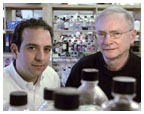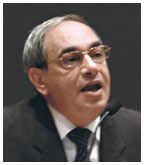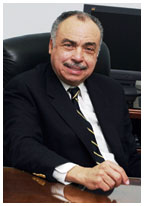
|
February 14, 2007: Notebook
Tuition remains flat, as room and board fees jump
King Day observance focuses on music
BREAKING GROUND—molecular biology
A sampler of new courses in the spring catalog
Alumni Day 2007: Honors, forums, tours, family fun
Princeton, Harvard nearly alone on early admission
Tuition remains flat, as room and board fees jump
In January, University trustees approved a budget with no undergraduate tuition increase for the first time in four decades, but the $1.1 billion budget also raised room and board by more than 19 percent for an overall fee hike of 4.2 percent in 2007–08, Princeton’s lowest since 2001–02. The budget will fund new initiatives, including two programs aimed at making the University more “family friendly” for graduate students, faculty, and staff.
Princeton spokeswoman Cass Cliatt ’96 said the higher room and board fees will support “significant improvements” in dining options. Room and board “have been heavily subsidized by the University,” she added, so the changes will help balance income and expenses. The combined cost of room and board will increase from $9,200 to $10,980. On-campus undergraduates with full meal plans will pay $43,980 in tuition, room, and board.
The two significant family-minded measures added to the budget are a fully funded three-month break from academic work for Ph.D. students who give birth, and a child-care grant program for faculty and staff. The Priorities Committee, which includes administrators, faculty, and students, said that the childbirth policy will provide a formal structure to replace the ad-hoc arrangements that departments had made for graduate student mothers in the past. A second graduate school proposal to add a semester of tuition, stipend, and enrollment status for birth mothers and primary caregivers of adopted or birth children was not funded, but the committee “recognized the great desirability” of adding that plan in the future.
The trustees also approved a $400 annual grant for each international undergraduate on financial aid who lives outside North America. The grant is intended to help cover the costs of activities during the winter break, such as “travel to a friend’s home, meals when the dining halls are closed, or day trips for culture and entertainment.” The University’s financial aid policy funds two trips home each year for residents of the United States, Canada, and Mexico, but only one trip home for students who live outside North America.
The budget also calls for an increase in salary pools for faculty and staff and a handful of new staff positions, most notably a new assistant dean of students for student discipline and crisis management. In recent years, discipline and crisis cases have increased in “number and complexity,” according to the Office of the Dean of Students’ request to the committee, and “students and parents are more inclined than in the past to challenge decisions, appeal to others within the institution, and seek external recourse.”
The budget for 2007–08 is 6.3 percent larger than the most recent
estimate of spending for 2006–07, according to the Priorities Committee
report. Investment income is projected to fund about 41 percent of the
budget in the coming year. ![]()
By B.T.

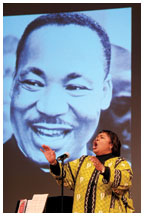 |
King Day observance focuses on music
Soprano Rochelle Ellis performs before an image of Martin Luther King
Jr. during the University’s annual King Day celebration Jan. 15
in Richardson Auditorium. The theme was the music of human rights movements,
and associate professor Daphne Brooks described in her keynote address
how songs of the civil rights era were “a sound that galvanized
the masses.” Jazz guitarist Stanley Jordan ’81, who performed
several pieces, told how he had been inspired by King to pursue his dreams
in the music world. “You can be a person of peace in your heart
and still get out there and be a fighter, as Dr. King was,” Jordan
said. ![]()

BREAKING
GROUND—molecular biology
In
search of a genetic ‘off switch’ for HIV
Work by Princeton researchers could open the door to a new
class of drugs
Leor S. Weinberger, left, and Thomas Shenk study viruses in Shenk’s molecular biology lab. (Frank Wojciechowski) |
Since the 1990s, doctors have known that anti-viral drug cocktails can help to reduce the presence of HIV in infected patients, but when patients stop taking the drugs, the virus rebounds. For the better part of a decade, researchers have been trying to figure out exactly how HIV manages to switch itself “off” and “on.”
In December, Leor S. Weinberger, a postdoctoral researcher working in the lab of molecular biology professor Thomas Shenk, presented a new explanation in a paper published in the journal Public Library of Science Biology. Weinberger and Shenk showed that one powerful circuit that an HIV virus uses to produce more of itself also can be used to shut the virus off.
Weinberger used a simplified version of HIV for the experimental work, basically cutting out extraneous parts of the virus so that he could zero in on that circuit, which is called the transactivator of transcription (or “Tat”) circuit. His research also employed computational biology to explain the behavior of the biological circuit — “just like electrical engineers use mathematics to figure out when their circuits will turn on and off,” he says.
With a better understanding of how viruses turn on and off, pharmaceutical researchers could apply the concept to make a new class of drugs for treating HIV and other viral illnesses. So Weinberger is building on his recent finding, working to understand other circuits used by HIV and to find similar mechanisms in Human Cytomegalovirus (HCMV), a herpes virus that is the primary focus of Shenk’s lab. Weinberger also hopes to apply his research to “piggyback viruses,” genetically modified versions of viruses such as HIV that could be used to fight the spread of infection.
Like most postdoctoral researchers, Weinberger’s focus is on his laboratory work, but he has found time to teach as well, leading a seminar on HIV and assisting with Professor David Botstein’s math course for biologists.
Working with viruses is an exciting field, Weinberger says, because
of the potential for curing or treating diseases. Beyond that, viruses
have played a role in some of the most important biological breakthroughs
of the last century, including the study of DNA and the discovery of cancer-causing
genes. “[Viruses] have an exceptional track record,” he says.
“They’re just great tools to learn about how mammalian systems
work.” ![]()
By B.T.

(Shin jae Won ’09) |
“History is still undecided. We all have the duty to help history make the right choice. … You can’t imagine how many sleepless nights I’ve had, wondering whether I should be proud or regret that I’ve had a minor contribution to the peace process.”
Afif Safieh, head of the PLO Mission to the United States, speaking
Jan. 15 in Robertson Hall on “Israel/Palestine: History Is Undecided.”
![]()

A sampler of new courses in the spring catalog
The list of courses offered at Princeton changes with each new term; as the spring semester begins, more than 115 courses are being taught for the first time. Topics range from “American Business History: The Rise of Corporate America” to “The Psychology of Morality and Politics” to “Seminar in Asian Art: Zen Painting for Novices.” Here’s a closer look at six new courses, with the “description/objectives” taken from the syllabi:
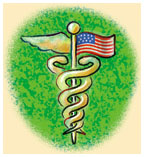 MOL
328: U.S. MEDICAL RESEARCH AND RESEARCHERS: HEALTH, HOPE, HUBRIS
Professors: Leon E. Rosenberg and Adel Mahmoud
MOL
328: U.S. MEDICAL RESEARCH AND RESEARCHERS: HEALTH, HOPE, HUBRIS
Professors: Leon E. Rosenberg and Adel Mahmoud
Description/objectives: Medical research aims to improve and maintain human health. Accordingly, researchers employ such strategies as understanding biology, defining disease mechanisms, and developing ways to prevent, treat, or cure. Today, the United States is the pre-eminent global power in medical research through interactions among government, academia, and industry. This course will trace the evolution of this country’s research enterprise, describe its diverse cultures, focus on its greatest achievements (and achievers), and identify a number of challenges confronting it currently. How America copes with these challenges will influence the future of world health.
Sample reading list: Michael Sargent, Biomedicine and the Human Condition; Jurgen Drews, In Quest of Tomorrow’s Medicines; David Cutler, Your Money or Your Life; Leon Rosenberg, The Physician Scientist; Shirley Tilghman, “Strange Bedfellows: Science, Politics, and Religion” (2005 lecture); Adel Mahmoud, The Global Vaccine Gap
Why is the budget for the National Institutes of Health four to five times larger than that for the National Science Foundation? One reason is that Americans want to lead long, healthy lives, says Leon Rosenberg, a medical doctor who teaches in the molecular biology department. Buoyed by strong government support, researchers in industry and academia have made the United States the leading power in the health sciences. But this was not always the case, Rosenberg notes, and America’s pre-eminence is far from guaranteed. Rosenberg and Adel Mahmoud, a senior policy analyst at the Woodrow Wilson School, plan to examine historical cases of medical breakthroughs and look at the obstacles researchers are likely to face in the next 50 years.
Both instructors bring a wealth of experience to the course, which Rosenberg says is aimed at “scientifically literate” students but not necessarily molecular biology concentrators. Rosenberg, a former dean of Yale Medical School, spent seven years at Bristol-Myers Squibb as president of its Pharmaceutical Research Institute, and Mahmoud’s past jobs include serving as chairman of medicine at Case Western Reserve University and president of Merck Vaccines. Guest speakers will include a Nobel Prize winner and a certain molecular biologist now working in Nassau Hall.
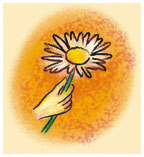 ENG
211: KNOWING INNOCENCE
ENG
211: KNOWING INNOCENCE
Professor: Lawrence N. Danson
Description/objectives: If you know innocence, you’ve already lost it. This course explores ideas of innocence (theological, sexual, judicial, and psychological) from Eden to Haight-Ashbury, concentrating on representations in fiction, poetry, politics, and anthropology. Readings include some great English authors (Shakespeare, Milton, Wordsworth) and some oddballs, too. We meet charming characters and scary ones (noble savages, wild boys, homicidal girls) and ask what cultural work innocence does in movies, photographs, advertisements, and other products of our fallen state. Terms to interrogate include: pastoral, primitivism, utopia, nature, nostalgia, and guilt.
Sample reading list: Mary Shelley, Frankenstein; Shakespeare, The Winter’s Tale; Henry James, The Turn of the Screw; Margaret Mead, Coming of Age in Samoa; Jean-Jacques Rousseau, Origins of Inequality; Spielberg-Kubrick, AI: Artificial Intelligence; Milton, Paradise Lost (excerpts); Richard Hughes, A High Wind in Jamaica
A paradox lies at the heart of the concept of innocence, Danson says: “It’s a state which defines who we are, precisely by what nevermore can be.” The one thing it never is, he adds, “is the here and now.” Innocence has been a wide-ranging myth that has been shaped in many ways, Danson says, and this course exposes students to a range of genres and approaches. Among the concepts to be explored are the “lost” golden age (Genesis, Paradise Lost), living outside civilization (Mead), political theory and living in a state of nature (the Wild Boy of Aveyron), utopia and technology (Shelley, the film AI), and how easily the idea of innocence can become threatening (James and Hughes). Christian belief in original sin and man’s fall from grace “depends on the wider myth of innocence and made it inescapable,” Danson says, and the experience of guilt and unhappiness requires the idea of innocence. “We are constantly reinventing ideas of innocence,” he says. Danson, named a Cotsen Faculty Fellow in recognition of his undergraduate teaching, has been a faculty member since 1968.
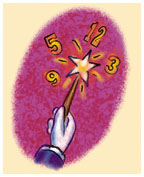 MAT
190: THE MAGIC OF NUMBERS
MAT
190: THE MAGIC OF NUMBERS
Professors: Manjul Bhargava *01, Lenhard L.
Ng
Description/objectives: This course will explore some of the intriguing and beautiful mathematics that underlie the arts, technology, and everyday life. This interactive course will cover materials ranging from prime numbers and encryption codes to Escher drawings, musical rhythms, games of chance, and mathematical designs in nature. Emphasis will be placed on discovering and analyzing patterns in a variety of contexts.
Sample reading list: Benedict Gross and Joe Harris, The Magic of Numbers
Mathematics plays an increasingly important role in today’s society, and it’s more important for students to have a basic understanding of math, Bhargava says. He developed this course for non-science majors to learn about math “as a subject of creativity and beauty”; the class’s 80 slots filled quickly. Live demonstrations and guest lecturers will demonstrate the relationships of mathematics to the visual arts, shape, and music; Bhargava will play the tabla while Duke professor Ng, a former classmate of Bhargava’s who is visiting on the Princeton faculty, will play the keyboard. Exploring how math is used in secure communications, students will exchange secret messages using the algorithm that encodes credit card numbers on the Web. Bhargava, a number-theory expert, joined the faculty as a full professor in 2003 at the age of 28, one of the youngest ever to receive that rank.
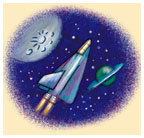 MAE
399/EGR 399: FASTER & HIGHER: THE ROMANCE AND REALITY OF SPACE FLIGHT
Professor: Roger C. Burk
MAE
399/EGR 399: FASTER & HIGHER: THE ROMANCE AND REALITY OF SPACE FLIGHT
Professor: Roger C. Burk
Description/objectives: An introductory aerospace engineering course for non-engineers. This course provides an elementary technical understanding of what it takes to explore and operate in outer space. We will cover the history of space flight, the space environment, rockets, orbits, launches, re-entries, spacecraft subsystems, and human factors. Students will work with the technical trade-offs in space mission design in weekly computer labs. Guest lecturers from the engineering and scientific communities will present case studies. Toward the end of the course students will lead critical evaluations of realistic science fiction and visionary nonfiction.
Sample reading list: Jerry Jon Sellers, Understanding Space: An Introduction to Astronautics; Wiley J. Larson and Linda K. Pranke, eds., Human Spaceflight: Mission Analysis and Design; Kim Stanley Robinson, Red Mars; Robert Heinlein, The Moon Is a Harsh Mistress
Science fiction imagines a spectacular range of prospects for the future of space exploration. Are any of them realistic, or even physically possible? By the end of the semester, students in Roger Burk’s space flight course should be able to provide answers to those questions and, in Burk’s words, “connect fascination with technical reality” using math and engineering.
Burk, a visiting systems-engineering professor from West Point, worked in space operations in the Air Force and is excited to return to those roots. He developed his course with help from Vincent Poor *77, now the University’s engineering dean, as part of Princeton’s effort to improve the ways in which it teaches engineering to non-engineers. Assessing the practical boundaries of space flight does not require particularly complex math — “algebra and maybe a smidgen of calculus,” Burk says — and space seems to be an area of science that appeals to engineers and non-engineers alike. The class’s 10 slots for engineers were snatched up quickly, and all but four of the other 30 seats were filled before the semester began.
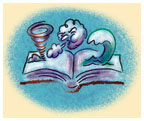 AMS
302: DISASTERS, CULTURE, AND SOCIETY
AMS
302: DISASTERS, CULTURE, AND SOCIETY
Professor: Lee B. Clarke
Description/objectives: Big disasters are with us as never before. Sept. 11, Katrina, and the 2004 tsunami loom large and have brought to the fore the importance of understanding how and why the world falls apart sometimes. Most people are barely aware of the meaning of disaster, but there are resources, academic and literary, that we can draw upon. This course will survey the major ideas in the inherently interdisciplinary field called “disaster research.” The course will be case-based, meaning that we will use specific cases as material for our conceptual inquiries.
Sample reading list: Lee Clarke, Worst Cases: Terror & Catastrophe in the Popular Imagination; Kai Erikson, A New Species of Trouble; Eric Klinenberg, Heat Wave: A Social Autopsy of Disaster in Chicago; Douglas Brinkley, The Great Deluge: Katrina, New Orleans, and the Mississippi Gulf Coast; Charles L. Bosk, Forgive and Remember: Managing Medical Failure; James Ridgeway ’59, The Five Unanswered Questions about 9/11; Steven Biel, Down with the Old Canoe: A Cultural History of the Titanic Disaster
Awareness of disasters in today’s society is growing, Clarke says, as more lives and property are lost and the magnitude of news coverage increases. But disasters — defined as occurring when a community is so disrupted that it needs outside support to re-establish its routines — “happen every day,” he says. By closely studying disasters, “you can peel away the veneer of society and see how society works.” Clarke, an associate professor of sociology at Rutgers University, is a visiting professor at Princeton for the spring semester as the Anschutz Distinguished Fellow of American Studies.
The course will explore how social inequalities make some people more vulnerable than others, and it will suggest “a richer way of thinking about people’s relationships to their environments,” Clarke says. “In our culture, the usual way to think is in an individualistic sense: I make my future,” but examples will show the influence of larger cultural forces. Students also will examine the kinds of things that they fear. “There’s a lot of debate in the humanities about what are the right things to fear,” Clarke says.
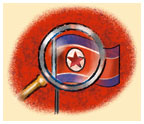 EAS
366: UNDERSTANDING NORTH KOREA
EAS
366: UNDERSTANDING NORTH KOREA
Professor: Joy S. Kim
Description/objectives: This course seeks to facilitate a better understanding of contemporary North Korea by examining the history of Korea’s colonial legacies and national division, and investigating the ways in which knowledge about North Korea is collected, produced, and consumed in the West. Students will learn to analyze current perceptions and debates by applying an understanding of how historical processes have informed multiple representations and narratives — ranging from “propaganda” to documentary films — of North Korea. This course is intended primarily for undergraduates who wish to deepen their historical and historiographical understanding.
Sample reading list: Bruce Cumings, North Korea: Another Country; Andrei Lankov, From Stalin to Kim Il Sung: The Formation of North Korea; Sonia Ryang, North Koreans in Japan: Language, Ideology, and Identity; Victor Cha and David Kang, Nuclear North Korea: A Debate on Engagement Strategies
From James Bond movies to State of the Union speeches, North Korea tends to be seen as “the stock figure for evil — a country America loves to hate,” according to Joy Kim, an assistant professor of East Asian studies. But Kim hopes to add depth to students’ views and put contemporary issues in context in her course, the first in the department to focus solely on North Korea. The class will explore how, beginning with the early 20th century, Korea’s history connects to recent events. Students will view representations of North Korea in the media and interact with guest speakers, including journalists and workers from nongovernmental organizations.
Much of the U.S. media coverage of North Korea focuses on Kim Jong-Il,
its leader, but Kim says that there are other elements worth exploring,
such as the influence of military leaders, the nation’s economic
crisis, and its dependence on foreign aid. Kim’s syllabus grew partly
out of research for a Princeton alumni education trip to North Korea on
which she was slated to be the study leader. After the trip, scheduled
for August 2006, was canceled, Kim decided to use her material to build
an undergraduate course. ![]()
By B.T. and W.R.O.

Alumni Day 2007: Honors, forums, tours, family fun
Julius Coles *66 (Photos courtesy Paul Sarbanes ’54; Julius Coles *66) |
Paul Sarbanes ’54
Five-term U.S. Sen. Paul Sarbanes ’54 and Africare President Julius Coles *66 will receive the University’s top alumni honors on Alumni Day Feb. 24, highlighting a schedule of social events and educational programs that includes morning lectures by the two honorees. Sarbanes and Coles also will join two Princeton professors and Woodrow Wilson School Dean Anne-Marie Slaughter ’80 for an afternoon panel discussion of the humanitarian crisis in Darfur.
Sarbanes, who recently retired after four decades in elective office, was selected to receive the Woodrow Wilson Award, presented annually to an undergraduate alumnus. He earned acclaim as a co-sponsor of the Sarbanes-Oxley Act, which reformed securities laws in the wake of the Enron and WorldCom scandals.
Coles, who received his master’s in public affairs from the Woodrow Wilson School, will be awarded the James Madison Medal, given to a distinguished graduate alumnus. Coles spent 28 years working in Asia and Africa for the U.S. Agency for International Development and later worked in academia. In 2002, he became president of Africare, a nonprofit organization that provides aid for food security, agriculture, and health initiatives in 26 African countries.
Alumni Day, first celebrated in 1915, draws more than 1,000 Princetonians back to campus each February. This year, Princeton faculty members will speak about topics ranging from health care in the United States to the challenges of building self-guided vehicles. Family programs include a Beatrix Potter-themed exhibit at the Cotsen Children’s Library, a performance by Princeton’s Juggling Club, scavenger hunts in the Art Museum, and guided tours to explore the dinosaur skeletons in Guyot Hall.
Alumni in town Feb. 23 can attend “This Is Princeton,” the University’s annual talent showcase at 8 p.m. in Richardson Auditorium, featuring students, faculty, staff, and alumni. Admission is $10; proceeds benefit local youth arts programs.
Additional Alumni Day details are available online at the Alumni Council’s
Web site, alumni.princeton.
edu. ![]()

Princeton, Harvard nearly alone on early admission
When Harvard and Princeton announced in September that they were ending their early-admission programs, both schools said they hoped that other colleges would follow the same course.
But only the University of Virginia has taken similar action since then. Last month Yale President Richard Levin, who said in 2002 that he would like to see all schools give up early admission, said that Yale’s nonbinding early-action program would continue. “It was pretty clear that no one else was going to move,” Levin said.
Princeton officials say they are confident they made the right move, however.
“As time goes on, we’re convinced we’ve made the right decision,” Dean of Admission Janet Rapelye told PAW last month. “In some ways, it seems an even bolder statement now.”
In announcing that the University would end its binding early-decision program for the class that enters Princeton in the fall of 2008, President Tilghman cited two primary factors. The first was to move away from an application process that raised questions of fairness because students from minority and low-income backgrounds were less likely to apply for early admission.
The second was to give high school students more time to decide which college was right for them.
While this year’s pool of early-decision applicants was “slightly more diverse” than in past years, Rapelye said, the percentage of those who would qualify for financial aid was still substantially less than those in the overall applicant pool.
She said she was not concerned that Princeton’s goal of admitting the strongest possible class will suffer because other top schools will continue to offer early admission. “Given that we have more than 18,000 applicants, and the strength of our [applicant] pool, it’s hard to imagine how any part of this puts us at a competitive disadvantage,” she said.
The admission office will keep a close watch to see if the number or quality of applicants changes in future years, she said.
Alumni reaction to Princeton’s early-decision action has tended
to reflect the experience of those “who have gone through the [admission]
process recently,” Rapelye said. College counselors, she said, “have
been absolutely applauding the decision.” ![]()
By W.R.O.

Courtesy “What’s Sacred? Princeton views” exhibition |
“Morning in Front of the Mosque,” left, a photo taken in
New Delhi, India, by Rachel Steinberg ’10 is one of more than 150
images submitted for an exhibition with the theme, “What’s
Sacred? Princeton Views.” Zachary Ruchman ’10’s photo
of a handwritten draft of a short story titled “A Thousand Words,”
shown below, received special commendation by the curators. A selection
of images by students, faculty, and staff is on display in Murray-Dodge
Hall through the end of the spring term. The exhibition was conceived
by Paul Raushenbush, associate dean of religious life. Photos can be viewed
on the Web at www.princeton.edu/~orl/whatssacred/.
![]()

KELVIN DINKINS ’09 is the first black student to be elected Triangle Club president. Dinkins, the only black actor in the fall show, also served as the club’s tour manager. He told The Daily Princetonian that he hopes to attract a larger audience and improve Triangle’s diversity: “It’s been a white club, so to speak.” Kendall Crolius ’76, chairwoman of Triangle’s board of directors, described Dinkins’ election as “a great moment” in the club’s history.
FAKHRUDDIN AHMED *75, the former head of Bangladesh’s central bank, was appointed head of the country’s caretaker government Jan. 12 in the midst of a political crisis. Ahmed, who holds a Ph.D. in economics from Princeton, worked previously at the World Bank.
Former Rep. JIM LEACH ’64, R-Iowa, has joined the Woodrow Wilson School faculty for three semesters as the John L. Weinberg/Goldman Sachs and Co. Visiting Professor of Public and International Affairs. Leach, who ended 30 years in Congress last month, is teaching a graduate course, “The Intersection of Chinese and U.S. Foreign Policy,” in the spring semester.
PETER SCHäFER, the Ronald O. Perelman Professor
of Judaic Studies, has received the Andrew Mellon Foundation’s Distinguished
Achievement Award for significant contributions to humanistic inquiry.
The award is for $1.5 million over three years. Schäfer said he hopes
to teach and develop new courses, create a chair in Hebrew Bible/Old Testament
studies, and bring postdoctoral fellows to Princeton to teach courses
in Israel studies. ![]()

MARTIN D. KRUSKAL, a leading mathematician affiliated with the University for 38 years, died Dec. 26 in Princeton. He was 81. Kruskal’s research ranged from nuclear fusion and the study of black holes to the soliton, an unusual wave form with applications in fiber-optic telecommunications. Kruskal began work at the Princeton Plasma Physics Lab in 1951, became a professor of astronomy in 1961, and in 1968 founded the Program in Applied and Computational Mathematics. He was named a professor of mathematics in 1979, transferring to emeritus status and joining the mathematics department at Rutgers University in 1989.
MARY ST. JOHN DOUGLAS, a medical researcher and one
of the first two women to serve as University trustees, died Jan. 4 of
congestive heart failure. She was 84. Douglas and Susan Savage Speers
were chosen in 1971 to serve 10-year terms as charter trustees, two years
after Princeton became coeducational. Douglas worked for nearly 40 years
at laboratories of the American Red Cross and the Naval Medical Research
Institute. ![]()

